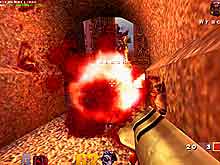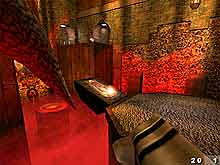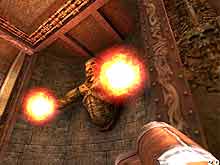|
For
the last five years or so, id Software has been the undisputed king of the
first-person shooter. With such classics as Wolfenstein 3D, Doom, Doom II, and
the original Quake, id dominated the genre it pioneered, and managed to stay one
step ahead of the competition--id's technology was without peer and its titles
had gameplay that was second to none. The company's latest offering, the
multiplayer-focused Quake III Arena, is easily the most anticipated game of the
year, and is clearly intended to forever solidify id's place as the premier
creator of first-person multiplayer games. Sadly, Quake III offers little more
than a beautified rehashing of what we've seen before, and fails to deliver any
real gameplay innovation.
Mmm, Curved Surfaces
The most noticeable difference between Quake III and its earlier iterations is
the graphics engine. During the game's development, fancy terms--such as
"curved surfaces," "trilinear flip-flopping," and other
words that only John Carmack understands--were bantered about, and every new
screen shot of a curved doorway or giant tongue brought oohs and ahs from the
fans. Needless to say, all the hype was well-founded: Quake III looks amazing.
Atmospheric fog lingers along the ground; beautiful flames flicker from medieval
torches; and the water effects are outstanding. All these pretty pictures carry
a big caveat, however: You're going to need a behemoth of a system to really
appreciate these effects. In fact, on a Pentium II-266 with 128MB of RAM and a
16MB TNT card (a system more powerful than the game's minimum specs), Quake III
chugged like an overweight couch potato. It'll take nothing short of a Pentium
III-500 with 128MB of RAM and a cranked Nvidia GeForce 256 video card to view
this game in all its glory.

Not to be outdone, the weapon effects are also extremely impressive. Rockets
leave smoke trails in their wake; the balls of energy from the pulse gun glow
with an evil shine; and the lightning gun must be seen to be believed. But the
most impressive graphical feat is the player models.
Abandoning the angst-ridden space-marine motif that id made famous, the
player models in Quake III run the gamut from the charred Cadavre, to the
horrific alien Klesk, to the flesh-deprived Bones. Each of the models has
different sounds, movements, and ways in which it carries weapons. It also dies
a horrible, blood-splattering death when fragged, showering any nearby
combatants with buckets of gore. This is the way deathmatch is supposed to look.
Pretty pictures aside, the real heart of any game is its gameplay and whether
or not it offers up something fresh, something original. And though it's quite
obvious that Quake III's graphics are well done and its technology pushes the
envelope, the same cannot be said about its gameplay.
Mortal Kombat Meets Doom Marine
Although it was designed primarily as a multiplayer experience, Quake III does include a minimalist single-player game. Billed as a first-person Mortal
Kombat, Quake III's solo game unfolds across seven tiers; to complete each tier, you must battle across three maps, then go toe to toe with the tier's end boss. The seventh tier features the final showdown with
Xaero, the end all and be all of end bosses.

Don't let all that fancy talk of tiers and end bosses fool you, though; single-player Quake III is nothing more than a series of bot matches. And though the bots offer a good challenge, they lack any real personality or style. In fact, about the only thing that distinguishes one bot from another is weapons preference. The bots use canned phrases, such as "I didn't see that one coming, Billy," and mutter garbage about how you're going to get your butt kicked later in the game. But all this chitchat becomes tiresome real quick. After you blow through the single-player game, you'll never feel the need to repeat the experience.
Creating a LAN game that is populated with bots isn't much more fun, especially in Capture the Flag. To issue orders to the bots on your team, you must hit the Escape (Esc) button and access a menu system in which you click the bot's name, then issue your orders; you can also issue a blanket order for the entire team. Now imagine doing this when you have 30 health, are out of ammo, and have the enemy's flag. It's an extremely convoluted process that slows the game to a crawl and takes away a lot of the intuitiveness. It could have been handled better with key commands.
Deathmatch 'Til You Drop
Of course, id's patented multiplayer mayhem is Quake III's real draw, and if you're a fan of Quake-style deathmatch, then the game does not disappoint--the action is fast, furious, and in your face. Four gameplay modes are included: Deathmatch, Team Deathmatch, One on One, and Capture the Flag. Each of these games will be satisfying if you're a hard-core Quake head. But if you have tired of the same old deathmatching, then you will find little in these games to hold your interest.
That's not to say Quake III's deathmatch isn't fun, because it is. In fact, it's a lot of fun. But the simple fact is that it's the same game we've played a million times before. There's only so far the basic deathmatch can go, and that well was getting a bit dry back in the days of Quake II. It wouldn't be such a big deal if Quake III included a multitude of multiplayer games, but that's not the case. More imagination should have been put into rounding out Quake III's offerings, especially in light of the fact that more and more players are migrating to team-based multiplayer games. If nothing else, id could have bought or licensed some of the better Quake II mods, such as Jailbreak and Q-Pong, and incorporated them into Quake III.
The biggest disappointment, however, is the omission of the CTF grappling hook. This was a design decision made by id, and I think it was a big mistake. The grappling hook was what made CTF unique, and it added an entirely new strategic element not seen in normal
deathmatch. You could hide, swing away from attackers, and set up formidable base defenses. Without the grappling hook, Quake III's CTF is little more than a team-based deathmatch that happens to have flags.
Stupid LPB!
Unfortunately, my complaints about Quake III extend beyond gameplay issues. Ping times, though decent, aren't as low as you would expect, especially considering the amount of testing this game endured. On my solid 56K connection at home, the average ping was around 300, and if there were more than 10 players, the game became nearly unplayable. Even over Gamecenter's ultrasleek T-line connection, I experienced latency problems and huge spikes that brought the game to a crawl. It should be noted that I thoroughly tested Unreal Tournament both at home and at work and enjoyed good pings at both places, with minimal problems.

My other big complaint stems from one of the game's "features." According to Carmack's .plan file, whenever someone joins a game, a temporary model is loaded; the correct model is loaded when the scoreboard is accessed, usually when someone is fragged. This sounds good in theory, but in practice, it's a pain in the backside. The game will hitch for a few seconds, as the new model is loaded. I experienced these hitches in LAN games, online, and in games in which it was only me and several bots (none of which, obviously, were exiting or entering the game). After a while, I became extremely annoyed with the entire process. There should be a way to disable this feature.
Is the King Dead?
The most disheartening aspect about Quake III is the total lack of any sort of gameplay innovation. Clearly a great deal of time and effort has been spent developing the graphics engine and designing some of the most amazing levels I've ever seen (especially the "bouncy" levels), but some of that time should have been spent designing a new multiplayer experience.
Why is that such a big deal? It's simple. In the two years since Quake II was released, the face of multiplayer action gaming has changed. With games such as Rainbow Six, Tribes, and Unreal Tournament pushing the multiplayer-gaming envelope, Quake III's offering seems rather anemic. And as much as I hate to compare Quake III to Unreal Tournament, the variety of games and plethora of options in Unreal Tournament clearly make it superior to Quake III. Sure, Unreal Tournament has a great deathmatch mode, but it also features games such as CTF, Assault, and Domination. Even if you hate straight deathmatch, Unreal Tournament is still worth picking up. The same cannot be said of Quake III. Why play straight deathmatch when you can take out scumbag terrorists or assault a darkened, razor wire-lined beach?
In the end, whether or not you like Quake III Arena comes down to a matter of preferences. If you want nothing more than hour after hour of mindless
deathmatching, then id's latest fits the bill perfectly. If, however, you're ready to move past that and experience something new, then you're better off with Unreal Tournament. Quake
III Strategy Guide is available here.
Visit Q3Arena.com and PlanetQ3.com
to fulfill all your Quake needs.
System Requirements:
Pentium II-233Mhz, 64MB RAM, 4MB OpenGL-supported 3D graphics accelerator,
25MB disk space, 56K Internet connection
Recommended:
Pentium II-350, 128MB RAM, 16MB OpenGL-supported 3D graphics accelerator
Summary:
Rating: 7
The good: The
graphical bells and whistles are simply incredible;
great-looking player models; awesome level design.
The bad: The single-player
game is a waste of time; the multiplayer game offers little more
than standard deathmatch; the BFG has been stripped of its
finesse.
The bottom line: Quake III
Arena is long in technological advances, but short in innovative
gameplay.
Multiplayer: Above average
Single player: Poor
ESRB rating: M (Mature)
Courtesy: CNET
GameCenter.com
|





